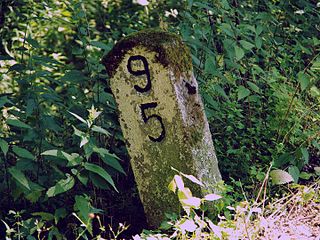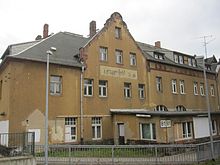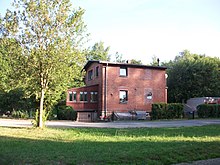Lengenfeld – Göltzschtalbrücke railway line
| Lengenfeld (Vogtl) –Göltzschtalbrücke | |||||||||||||||||||||||||||||||||||||||||||||||||||||||||||||
|---|---|---|---|---|---|---|---|---|---|---|---|---|---|---|---|---|---|---|---|---|---|---|---|---|---|---|---|---|---|---|---|---|---|---|---|---|---|---|---|---|---|---|---|---|---|---|---|---|---|---|---|---|---|---|---|---|---|---|---|---|---|
| Route number : | 6667; sä. LMG | ||||||||||||||||||||||||||||||||||||||||||||||||||||||||||||
| Course book range : | DR: 443 (1973) | ||||||||||||||||||||||||||||||||||||||||||||||||||||||||||||
| Route length: | 12.104 km | ||||||||||||||||||||||||||||||||||||||||||||||||||||||||||||
| Gauge : | 1435 mm ( standard gauge ) | ||||||||||||||||||||||||||||||||||||||||||||||||||||||||||||
| Maximum slope : | 17 ‰ | ||||||||||||||||||||||||||||||||||||||||||||||||||||||||||||
| Minimum radius : | 175 m | ||||||||||||||||||||||||||||||||||||||||||||||||||||||||||||
|
|||||||||||||||||||||||||||||||||||||||||||||||||||||||||||||
The Lengenfeld – Göltzschtalbrücke railway line was a branch line in Saxony . She started in the station of Lengenfeld (Vogtland) at the railway Zwickau-Falkenstein and led Göltzschtal to Mylau where the station Göltzschtalbrücke following the railway line Reichenbach Göltzschtalbrücke existed.
history
As early as 1885, a Lengenfeld committee demanded a railway from Lengenfeld via Mylau to Greiz in Thuringia , which should run technically easily in the Göltzschtal. Initially, the project, as well as a train from Reichenbach down to the Göltzschtal, was rejected. On June 21, 1893 a railway line leading from Reichenbach to Mylau was then licensed, which should have its end point at the Göltzschtal bridge. This line was opened on April 30, 1895.
However, the city of Lengenfeld continued to demand a railway line through the Göltzschtal to Greiz. On June 5, 1901, this route was also approved by the Saxon government. However, the desired continuation to Greiz could not be achieved. The city of Greiz sought a direct route from the upper train station in Reichenbach, which was not wanted by the Saxon side. In October 1901, construction began from both endpoints. From November 16, 1903, the first trains ran between Weißensand and Göltzschtalbrücke station. The entire route was opened on May 17, 1905.
From then on, train traffic was handled continuously between Lengenfeld and Reichenbach. Because of the low demand in passenger train traffic, mixed trains ran mainly. From 1935 on, a railcar was also used that covered the Lengenfeld – Reichenbach ob Bf route in exactly one hour.
Because of the dilapidated superstructure between Weißensand and Mühlwand, the sparse passenger traffic on the Wolfspfütz – Göltzschtalbrücke (–Reichenbach) section was transferred to a rail replacement service on December 15, 1957. Nor was he resumed later. On May 31, 1958, through freight traffic was also discontinued and the Weißensand – Mühlwand section closed. In 1967 the section Mühlwand – Göltzschtalbrücke was also closed. After 1970 only the line between Lengenfeld and Wolfspfütz remained in operation. A busy rush hour delayed the complete closure, which was actually planned for 1968. The last passenger trains did not run there until May 28, 1971.
The dismantling of the track at Weißensand only began in 1975. From 1984 onwards, only the track between Lengenfeld and Wolfspfütz station remained, which from then on served to park damaged wagons from Raw Zwickau . The last train ride to pick up the damaged wagons took place there on October 8, 1987, then the route was closed. The track was still there after the connection point in Lengenfeld was expanded in 1996, but today there is no longer a piece of rail in the Lengenfeld – Wolfspfütz – Weißensand section. From the former stop at the Lengenfeld cotton spinning mill, a cycle and hiking trail was created on the old section of the route to Mylau and on to the Göltzschtalbrücke, at the edge of which you can sometimes still find the old "milestones" (see picture) .
Route description
Starting from the Lengenfeld (Vogtl) station on the Zwickau – Falkenstein line , the entire length of the line ran through the middle Göltzschtal valley . At Weißensand the road bridge Göltzschtalbrücke (A 72) was crossed. With the exception of Weißensand and Mylau, most of the stations were not in the immediate vicinity of the village. When breakpoint Mylau anchor was railway Reichenbach Göltzschtalbrücke involved. The tracks of both railway lines ran parallel or later as a common track to the Göltzschtalbrücke station and ended after crossing under the Göltzschtalbrücke .
Operating points
Lengenfeld (Vogtl) ⊙
The station Lengenfeld (Vogtl) was after the operation opening of the railway line Zwickau-Falkenstein on November 29, 1875 in addition to Auerbach unt Bf the biggest stop of the railway line. In addition to the reception building (a type building), the goods shed and a farm building, a water station was also built.
From 1904 the station was completely rebuilt in connection with the construction of the Lengenfeld – Göltzschtalbrücke railway line, which opened in 1905. A completely new reception building was also built. Over the years, a number of connecting railways were added, and Lengenfeld (Vogtl) received its own Kö in the 1930s .
In the direction of the Göltzschtalbrücke station, train traffic between Wolfspfütz and Göltzschtalbrücke was suspended in 1958. Only after the rest of the line from Lengenfeld to Wolfspfütz was closed at the beginning of the 1970s did the importance of the station decline again. Today there are only three tracks left in the Lengenfeld (Vogtl) station, all the others were dismantled during the line renovation at the end of the 1990s.
Lengenfeld (Vogtl) cotton mill ⊙
The unoccupied stop at Lengenfeld (Vogtl) cotton spinning mill was opened on May 15, 1935 in the northwest of Lengenfeld near the cotton mill. It was mainly set up for workers in the surrounding factories. The station, which consisted only of a 135 meter long platform and a station sign, was subordinate to the Lengenfeld (Vogtl) station. After the last passenger trains ran on the Lengenfeld (Vogtl) –Wolfspfütz section on May 28, 1971, the station was closed on May 29, 1972. There were no buildings in the station for passenger traffic. At the location on "Polenzstrasse" ( Bundesstrasse 94 ) in the north-west of Lengenfeld, the goods shed (half-timbered building) is still preserved.
Wolf puddle ⊙
The station Wolfspfütz was opened on January 3, 1905 as a station devoted in the same year to the station. In addition to a wooden waiting hall and free access, the station had a car body on the platform for storing equipment. There were also three car bodies on the loading street that were used as makeshift goods sheds. Opposite the waiting hall, a civil servants' house was built at the entrance to Ladestrasse. Parallel to the main track there was a loading track integrated on both sides, to which a stump track was connected to the east and west. Between 1935 and 1954 the station was run as a stop. In 1960, the platform was extended by 65 meters and the western dead end was expanded.
After the end of continuous travel between the Lengenfeld (Vogtl) and Göltzschtalbrücke stations, Wolfspfütz station was the terminus for passenger trains from Lengenfeld on December 16, 1957. As a result, the loading track was required to move the trains. The station was subordinate to the Lengenfeld (Vogtl) train station until it was finally closed on May 26, 1972.
The Wolfspfütz station was located about 750 meters north of the village in the valley of Wolfspfütz Göltzsch. Of the high-rise buildings, only the civil servants' house exists today, which is provided with a plaque. A rest area was created on the site. The route was expanded into a cycle path in the Wolf Puddle.
White sand ⊙
The Weißensand stop was opened as a freight loading point on November 16, 1903 and dedicated to the station in 1905. It consisted of a bypass and a dead-end track, three switches, a platform, a wooden waiting hall, free access, car body and a loading lane with an additional car body and cattle ramp. After the station was downgraded to a stop in 1933, it was again a train station in 1936 with the construction of the autobahn (today's federal autobahn 72 ). Her track systems were expanded and the track systems of the bridge construction site were placed under her control, as a large part of the building material was delivered by rail. After the motorway was completed in 1939, the loading station was dismantled and the Weißensand station was downgraded to a stop. Between 1941 and 1958 the station was subordinate to the Göltzschtalbrücke station, after which it came under the jurisdiction of the Reichenbach (Vogtl) station and Bf .
After the cessation of passenger traffic, the Weißensand station was only a loading point from September 29, 1957. In 1968 it went completely out of service. There are no more buildings. At the former location there is now a roundabout and a garage complex. The bridge following the station exit in the direction of the Göltzschtalbrücke station was rebuilt as part of the expansion into a cycle path.
Cutting Bach ⊙
The unoccupied Schneidbach stop went into operation with the opening of the Göltzschtalbrücke – Weißensand section on November 16, 1903. However, it was not used until the entire line opened on May 16, 1905. The station in the valley of the Göltzsch was about one kilometer west of the village of Schneidbach. It was only used for passenger traffic and had a typical wooden waiting hall without windows, a free pass and a car body. In the direction of the Göltzschtalbrücke there was a bridge over the Mühlgraben behind the station and then the only overpass on the railway line. The farm road leads over this from Buchwald to Schneidbach past the excursion restaurant "Forsthaus Mylau".
The station was subordinate to the Mylau station until May 31, 1923 , then to the Göltzschtalbrücke station until December 31, 1958. The station was then subordinated to the Reichenbach (Vogtl) train station and Bf .
On September 29, 1957, the Schneidbach stop went out of service. The wooden waiting hall was moved to the entrance of Schneidbach in the direction of Weißensand, where it served as a bus waiting room until it was demolished in 1994. The station sign also remained on the building until this time.
Mühlwand ⊙
The Mühlwand stop was opened on November 16, 1903 and elevated to a station in 1905. As soon as the route was opened, goods traffic was restricted at the station. The station had a waiting hall, a house for the head of the station (above the entrance to the loading street), a free pass and three car bodies. The track system consisted of five points, a bypass track, two butt tracks and a siding to the "Glaß worsted spinning mill". This ensured extensive shunting traffic in the station. Since September 1, 1933, the station has been used as a stop again. It was subordinate to the Mylau station until 1923 , to the Göltzschtalbrücke station until 1958 and then to the Reichenbach (Vogtl) station under Bf .
Because of the ailing superstructure between the Weißensand and Mühlwand stations, the sparse passenger traffic at the time on the Wolfspfütz – Göltzschtalbrücke (–Reichenbach) section was transferred to a rail replacement service on December 15, 1957. The Mühlwand station had been used as a loading point since September 29, 1957. On May 31, 1958, through freight traffic was also discontinued and the Weißensand – Mühlwand section closed. With the closure of the Mühlwand – Göltzschtalbrücke section, the Mühlwand loading point went out of service in April 1966. Today only the residential building belonging to the station on “Mylauer Straße” reminds of the stop. There is now a parking lot on the site of the station in the center of the village. The route in the direction of Mylau was expanded into a cycle path.
Mylau Bad ⊙
The unoccupied Mylau Bad stop was opened on May 15, 1935. It was located in the direction of the Göltzschtalbrücke east of the Mylau outdoor pool, to which an access path led from the rear entrance to the platform. Immediately after the station, the Göltzsch was crossed in the direction of Mylau. The Mylau Bad demand stop was only served during the opening times of the outdoor pool in the summer months. It could be reached via “Lengenfelder Straße” and had no high-rise buildings. The station was closed again on December 16, 1945.
Mylau Hp ⊙
After the city of Mylau with the stations Mylau Bahnhof and Mylau stop (renamed Bahnhof Göltzschtalbrücke in 1905 ) on the Reichenbach – Göltzschtalbrücke railway line received a railway connection, the municipality received another station on November 16, 1903. Mylau Haltpunkt was only served by trains when the entire line to Lengenfeld was opened on May 17, 1905. In 1911 the name was changed to Mylau Hp . The unoccupied station was on the edge of the old town of Mylau directly on the western bank of the Göltzsch. It could be reached via “Lambziger Straße” and had a 100-meter-long platform, a wooden waiting hall with a toilet and a car body. In the direction of the Göltzschtalbrücke station, the Göltzsch was crossed diagonally directly behind the station. Express goods were also processed at the station to a limited extent. The breakpoint was subordinate to the Reichenbach (Vogtl) train station and was decommissioned on September 29, 1957.
Mylau anchor ⊙
The Mylau Anker demand stop was put into operation on May 15, 1935 at the separation of the Reichenbach – Göltzschtalbrücke railway line from the Lengenfeld – Göltzschtalbrücke railway line. There was a platform for passenger traffic on both of the parallel railway lines. The station on "Netzschkauer Straße" got its name from the nearby inn "Zum golden Anker". After the end of the Second World War , the station was closed again on December 16, 1945.
At the turn of the year 1962/63, the track coming from Lengenfeld was expanded up to kilometer 11.6 of the Lengenfeld – Göltzschtal bridge. From then on, the trains only used the track of the Reichenbach – Göltzschtalbrücke railway line in both directions. A switchman's post was set up at the built-in turnout for both lines. During the handover trips in the direction of Lengenfeld, the switch was unlocked and set by the train crew. The two entry signals went out of service. With the discontinuation of the Mühlwand – Göltzschtalbrücke (route to Lengenfeld) in 1967 and Reichenbach unt Bf – Göltzschtalbrücke (route to Reichenbach above Bf) in 1970, the switch also went out of service.
Göltzschtalbrücke ⊙
The Göltzschtalbrücke station was opened as the Mylau stop on May 1, 1895 together with the Reichenbach – Göltzschtalbrücke railway line. With the opening of the first section of the Lengenfeld – Göltzschtalbrücke to Weißensand railway for goods traffic, the station was upgraded to a train station in 1903 and renamed the Göltzschtalbrücke . Since 1905, trains have also run from here to Lengenfeld. Originally a railway line to Greiz was to be built. Due to the First World War , this project was no longer carried out, so the pull-out track ended 80 meters behind the Göltzschtal bridge . The station was hardly of any importance for passenger traffic, it was mainly used for freight traffic. The stations Mylau Anker, Mylau Hp, Mylau Bad and Schneidbach were subordinate to the Göltzschtalbrücke station.
Passenger traffic was stopped on December 15, 1957 between Weißensand and Reichenbach (Vogtl) above Bf . Since then, the station has had the rank of a freight yard, which on January 1, 1959 was subordinate to the Reichenbach (Vogtl) station under Bf . From 1962 the station was only a loading point. Freight traffic to Mühlwand was given up on June 1, 1967 and to Reichenbach (Vogtl) and Bf on September 26, 1970. However, there were still occasional service trips to a siding in the station area. Wagons were parked in the station until 1971. In 1972 the station went out of service. At the location near the Göltzschtalbrücke , the station building, the railway maintenance office as well as the goods shed and farm buildings are still there today.
literature
- Erich Preuß , Reiner Preuß : Saxon State Railways . transpress Verlagsgesellschaft, Berlin 1991, ISBN 3-344-70700-0 .
- Wilfried Rettig : The railways in Vogtland, Volume 2 ; EK-Verlag, Freiburg 2002; ISBN 3-88255-687-0
- Günter Wengorz / Gero Fehlhauer: Memories of the Saxon branch line Reichenbach - Göltzschtalbrücke - Lengenfeld Brand Sachsendampf Verlag Jacobi, Reichenbach 2007, ISBN 978-3-937228-30-3
- Johannes Rieschel and Eberhard Schramm: The Vogtland branch line Reichenbach – Lengenfeld. (= Secondary railway documentation. Vol. 45), Kenning, Nordhorn 1998, ISBN 3-927587-96-6
Web links
Individual evidence
- ↑ http://www.bimmelbahn.de/pkurier/pkstill10.htm
- ↑ Book “Reichenbach und seine Ortsteile”, p. 116
- ↑ Gerd Betka: Jägerhaus Bridge: There is a risk of falling into the depths. In: Free Press. March 31, 2020, accessed March 31, 2020 .
- ^ The Schneidbach stop at www.sachsenschiene.net












